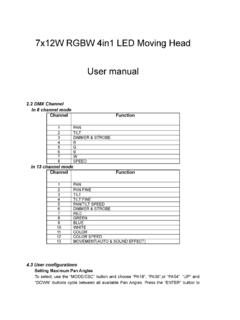Transcription of SAFETY OF PIPELINES IN CLOSE PROXIMITY TO …
1 1 of 6 SAFETY OF PIPELINES IN CLOSE PROXIMITYTO electric TRANSMISSION Dawalibi, Senior Member, IEEE, Y. Li, and J. Ma, Member, IEEESafe Engineering Services & technologies Viel, Montreal, Quebec, Canada, H3M 1G4 Tel.: (514) 336-2511 Fax: (514) 336-6144E-mail: Web: -- AC interference from high voltage power lines canconstitute an electric shock hazard and a threat to equipmentintegrity during both load and fault conditions. Mitigationsystems are usually installed to reduce the touch voltages so thatthe nearby metallic utilities are safe. This paper discusses thestates of the touch and step voltages for a few typical right-of-way systems under load and fault conditions. The effects of atypical mitigation system on the inductive interference levels arealso studied. The results presented in this paper clearly illustratethe SAFETY behavior of PIPELINES subjected to electromagneticinterference from neighboring electrical networks and theeffectiveness of Terms AC Interference, SAFETY , PIPELINES , touchvoltages, step voltages, potentials, induced voltages, mitigation.
2 I. INTRODUCTIONA pipeline which shares a common corridor with ACtransmission lines becomes energized by the magnetic andelectric fields surrounding the power system in the air andsoil. This AC interference can result in an electrical shockhazard for people touching the pipeline or metallic structuresconnected to the pipeline or simply standing , damage to the pipeline coating, insulatingflanges, rectifiers or even direct damage to the pipeline s wallitself can recent years, study of interference effects from ACpower lines in PIPELINES , railways, communications lines andother such structures and mitigating AC voltages induced inpipelines has resulted in numerous research reports, papersand standards [1-18]. These references show that thedetermination of interference effects in a typical right-of-wayis a complex procedure requiring not only a good knowledgeof conductor layout, power line and pipeline electricalcharacteristics and electrical system parameters, but also anaccurate representation of the soil structure [3].
3 Mitigation systems are designed to reduce touch voltagesand coating stress voltages to acceptable levels during powerline load and fault conditions. Lumped grounding,cancellation wires and gradient control wires are commonlyused mitigation approaches. Among them, the gradientcontrol method is the most effective and paper discusses the SAFETY states of three simple right-of-way scenarios during load and fault effects and the performance of mitigationsystems are illustrated for PIPELINES which are both paralleland non-parallel to the power lines. II. DESCRIPTION OF THE PROBLEMF igure 1 presents the complete model of a right-of-waynetwork (Model 1) for the case of a pipeline parallel to atransmission line (T/L) under fault conditions. The networkconsists of one transmission line and one pipeline. Themodeled portion of the T/L is about 10 km (9620 m) simplicity, only one phase conductor and the shield wirehave been modeled.
4 The phase conductor is 27 m abovegrade. The shield wire, an optical fiber conductor, is parallelto the phase conductor and is 35 m above grade. Its diameteris mm; its relative resistivity (with respect to copper) and relative permeability (with respect to free space) is1. The shield wire is connected to the neutral point at eachend through an appropriate impedance of 10 ohm to simulatea long T/L line . The T/L span length is 400 m. Each span isdelineated by a pole structure represented simply as a singlevertical wire connecting the shield wire to a 10 m long groundrod approximating the grounding afforded by the pipeline is centered length-wise in the corridor and is40 m away from the T/L center. The pipeline length ofexposure is 4400 m and this portion is parallel to the T/L. Ateach end of the exposure, the pipeline veers awayperpendicularly and continues for 1000 m before outer diameter of the pipe is 40 cm and its wall thicknessis 10 mm.
5 The pipeline is buried 2 m below grade. Therelative resistivity of the pipe wall is 12 and its relativepermeability is 250. The pipeline s effective coatingresistivity is 3,048,781 ohm-m (as computed based on aleakage resistance of ohm-m2 and a thickness of 5mm). A fault current of 12,500 A is assumed to be flowing2 of 6from each end of the transmission line during a fault at thecentral pole of the the case of a parallel pipeline under load conditions,two more phase conductors, on each side of the phaseconductor in Model 1 are added. The separation distancebetween adjacent phase conductors is 5 meters. A 1,000 Aload current is assumed to be flowing in the 3 phaseconductors of the T/L, with phase angles of 0, 120, 240degrees (Model 2), completed right-of-way network (Model 1).For the case of a non-parallel pipeline under faultconditions, Model 1 is used, but the pipeline is rotated 15degrees with respect to the mid-point along the transmissionline.
6 A fault current of 12,500 A is again assumed to beflowing from each end of the transmission line during a faultat mid-point (Model 3).A highly effective means of mitigating excessive pipelinevoltages is the installation of gradient control wires. In thispaper, a typical mitigation system is applied to the exposedpipeline for all the cases studied. A bare, continuous, 14 mmdiameter conductor is buried at a depth of m, with a 1 mhorizontal separation from the pipeline, on the side closet tothe transmission line . The wire is regularly bonded to thepipeline (every 200 m for the first 400 m at each end andevery 400 m for the rest of the middle portion of thepipeline). The gradient control wires not only provide goodgrounding for the pipeline and thus lower the magnitude ofthe pipeline potentials, but also raise earth potentials in thevicinity of the pipeline such that the difference in potentialbetween the pipeline and the local earth is reduced.
7 As aresult, touch voltages and coating stress voltages aresignificantly reduced. III. METHODOLOGY OF THE STUDYThe field theory approach is used to carry out the field approach is based on electromagnetic theory. Ittakes into account the inductive, capacitive and conductiveinterference effects between all the elements in the network inone single step. In order to get results with higher accuracy, anumerical evaluation (Gaussian integration method) ofSommerfeld integrals is used instead of an analyticapproximation [19-22].For the purpose of computing touch voltages in the vicinityof the pipeline, 11 profiles on the earth surface above thepipeline are specified, starting at one end of the pipeline andending at the other (the length of each profile is 4600 m). Theseparation distance between two adjacent profiles is 1 m (seeFigure 1). The touch voltage computed here is the differencebetween the earth potential at an observation point and theground potential rise (GPR) of a conductor segment whichresults in the greatest touch voltage and which is partially orwholly within a 6 m radius of the observation point (feetlocation).
8 This 6 m radius is selected to account for thepossibility of a ground metallic structure extending up to 6 mfrom its ground bonding point. First, earth surface potentialswere calculated along the profiles, then subtracted,accounting for phase angle, from the potential rise of thepipeline segment described the step voltage computation, two more sets of profileson the earth surface are specified. The first set consists of 6profiles which are perpendicular to the pipeline and arelocated at the center of the pipeline (fault location). The otherset has 5 profiles, which are located at one bending point ofthe pipeline (see Figure 1). The step voltages are computed ateach observation point with the maximum difference inpotentials between that point and any other observation pointwithin a 1 m stride of that point. IV. ANALYSIS AND DISCUSSIONThis study was performed using the field-based approach[10].
9 The threshold values of the safe touch and step voltages,which are used as a criterion in extracting and reporting unsafe observation points in a 2D spot plot (Figures 3 and4), are computed for a backup fault clearing time of and a 100 ohm-m uniform soil. The safe touch andstep voltages are V and V, Pipeline Parallel To Transmission line Under LoadConditionFigure 2 shows the touch voltages along the pipelinewithout mitigation, under load conditions. The touch voltagecurve is symmetric due to the symmetry of the system, asexpected. The minimum touch voltage occurs at the center of3 of 6the pipeline. This is because, due to the symmetry of thesystem, the induced EMF in the pipeline on both sides of thispoint are the same, resulting in a minimum leakage currentfrom the pipeline at this point. Since leakage current isresponsible for the potential rise of the pipeline, the pipelinepotential is therefore at a minimum at this point.
10 The touchvoltage is the difference between the pipeline potential andearth surface potential. Because the earth surface potential isvery small ( CLOSE to 0 V), the touch voltage is actually veryclose to the pipeline potential. The maximum touch voltageoccurs at the two bending points of the pipeline. This isbecause the strong discontinuity of the EMF at these twopoints forces a large leakage current from the pipeline,resulting in large pipeline potentials, and therefore largetouch voltages at these two points. The maximum touchvoltage exceeds 15 V and therefore requires mitigation,according to North American SAFETY standards for loadconditions [17, 18].Fig. 2. Touch voltages along the pipeline under load conditions, is expected that step voltages are very low because theearth surface potentials are very low under load conditions. Infact, the maximum step voltage is only V, occurring atthe pipeline bending points.








